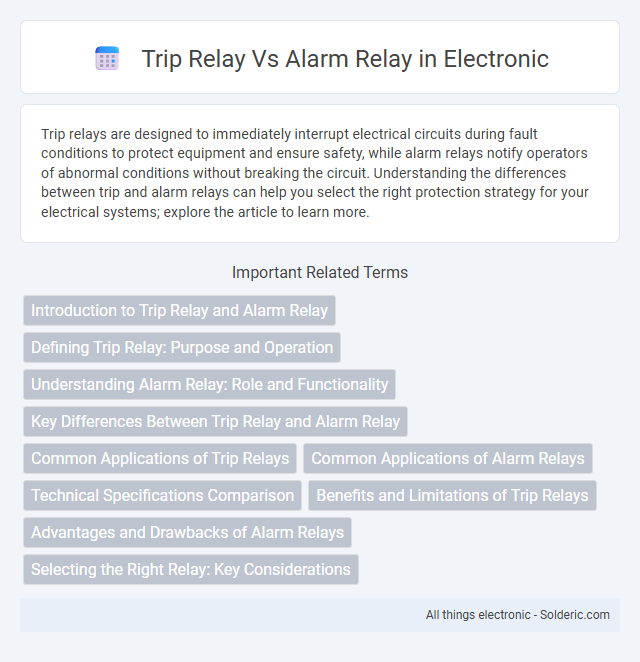Trip relays are designed to immediately interrupt electrical circuits during fault conditions to protect equipment and ensure safety, while alarm relays notify operators of abnormal conditions without breaking the circuit. Understanding the differences between trip and alarm relays can help you select the right protection strategy for your electrical systems; explore the article to learn more.
Comparison Table
| Feature | Trip Relay | Alarm Relay |
|---|---|---|
| Purpose | Initiates immediate shutdown or safety action during a fault. | Signals warning conditions without triggering shutdown. |
| Function | Activates to trip circuit breakers or protection devices. | Activates to alert operators of abnormal but non-critical conditions. |
| Response Time | Fast, designed for immediate action. | Moderate, focuses on notification. |
| Typical Applications | Fault protection in electrical systems, machinery shutdown. | Condition monitoring, preventive maintenance alerts. |
| Output Contacts | Usually normally closed (NC) contacts that open on trip. | Usually normally open (NO) contacts that close on alarm. |
| Impact | Directly interrupts power or operation to prevent damage. | Does not interrupt operation but prompts inspection or action. |
Introduction to Trip Relay and Alarm Relay
Trip relays and alarm relays serve distinct roles in electrical protection systems, where a trip relay is designed to initiate a circuit breaker operation to disconnect power during fault conditions, preventing equipment damage or hazards. An alarm relay, on the other hand, triggers warnings or signals to notify operators of abnormal situations without directly interrupting the power flow. Understanding these differences helps you optimize system safety and response efficiency.
Defining Trip Relay: Purpose and Operation
A Trip Relay is designed to quickly interrupt electrical circuits in response to fault conditions, protecting equipment and ensuring safety by initiating shutdowns or isolations. Unlike Alarm Relays, which signal warnings without disrupting power, Trip Relays actively trigger protective devices such as circuit breakers. Your system relies on Trip Relays to prevent damage and maintain operational integrity during hazardous events.
Understanding Alarm Relay: Role and Functionality
Alarm relays serve as critical components in monitoring systems by signaling abnormal or fault conditions to ensure timely responses. Unlike trip relays that initiate equipment shutdowns for safety, alarm relays alert you to potential issues without interrupting operation. Their functionality includes activating visual or audible alarms, enabling preventive maintenance and enhancing overall system reliability.
Key Differences Between Trip Relay and Alarm Relay
Trip relay and alarm relay serve distinct functions in electrical protection systems, where the trip relay activates to disconnect power during fault conditions, ensuring equipment safety and preventing damage. Alarm relay, on the other hand, signals abnormal conditions without interrupting the circuit, alerting operators to potential issues for timely intervention. Understanding the key differences between trip relay and alarm relay helps you choose the appropriate device based on whether immediate disconnection or notification is required in your protection scheme.
Common Applications of Trip Relays
Trip relays are commonly used in industrial safety systems to immediately disconnect power during fault conditions, protecting equipment and personnel from damage or injury. They are integral to circuit breakers, emergency stop circuits, and motor protection devices, ensuring rapid response to hazardous events. Your safety setup relies on trip relays for fast and reliable interruption of electrical power when abnormal conditions are detected.
Common Applications of Alarm Relays
Alarm relays are commonly used in industrial automation and safety systems to signal abnormal conditions such as equipment malfunctions, fire detection, and security breaches. They activate visual or audible alarms to alert operators and trigger safety protocols to prevent damage or injury. Unlike trip relays, which directly interrupt power to machinery, alarm relays primarily provide early warning and monitoring functions.
Technical Specifications Comparison
Trip relays typically operate at lower voltage ratings, commonly 24-240V AC/DC, and are designed to initiate circuit interruptions upon fault detection. Alarm relays function within similar voltage ranges but prioritize signaling and notification, often featuring auxiliary contacts rated for lower current loads, such as 5A at 250V AC. Both relays differ in contact configuration, with trip relays favoring normally closed contacts to ensure safety shutdowns, while alarm relays frequently use normally open contacts for activation of alert systems.
Benefits and Limitations of Trip Relays
Trip relays enhance electrical safety by swiftly disconnecting circuits during fault conditions, reducing equipment damage and preventing electrical hazards. They offer reliable operation and are integral to protective relay systems, but their limitations include potential false trips caused by transient disturbances and the need for precise calibration to avoid unnecessary outages. Understanding these benefits and limitations helps you optimize system reliability and minimize downtime.
Advantages and Drawbacks of Alarm Relays
Alarm relays provide real-time notifications of abnormal conditions, enabling immediate response to potential system faults and enhancing safety protocols. They are advantageous for continuous monitoring and proactive maintenance but may result in frequent false alarms if sensitivity settings are not properly calibrated, leading to operational disruptions. Compared to trip relays, which directly trigger protective shutdowns, alarm relays offer early warnings without interrupting system functions, balancing caution with operational continuity.
Selecting the Right Relay: Key Considerations
Selecting the right relay involves understanding the specific function and application requirements, such as whether a Trip Relay is needed to interrupt a circuit during fault conditions or an Alarm Relay to signal an abnormal condition without interrupting the circuit. Key considerations include the relay's response time, contact configuration, voltage rating, and integration compatibility with protection and monitoring systems. Evaluating the protection scheme and operational environment ensures optimal relay performance and system reliability.
Trip Relay vs Alarm Relay Infographic

 solderic.com
solderic.com